The Newe Testamente Faythfully Translated
Zürich: Christoffer Froschauer, 1550.
[11], CCCCXLVI, [1] leaves : ill. ; 13 cm.
An extensively damaged copy of William Tyndale's New Testament; published in Zürich in 1550. This copy is erroneously associated with another early translator, Miles Coverdale. The illustrated initials are particularly engaging.
Tyndale's first complete version of the New Terstament was printed in Worms in 1526. He revised the work in 1534. He was imprisoned outside of Brussels in 1535 and tried for heresy. In October 1536, he was strangled and then his body was burned. The King James Version made great use of his translation.
San Francisco Theological Seminary Collection
|

|
|
Tyndale's New Testament, 1550.
|
Miles Coverdale, Biblia: the Byble, that is, the holy Scrypture of the Olde and New Testament, faithfully translated out of Douche and Latyn in to Englishe.
[Marburg]: [Eucharius Cervicornus and Johannes Soter], 1535.
Coverdale based his New Testament on Tyndale's well known translation. The sources for the Old Testament include Tyndale's work for the Pentateuch and Jonah. The remaining books were translated from Luther's German Bible, the Zurich Bible, the Vulgate and other Latin sources.
From the Howell Bible Collection, The Pacific School of Religion
|

|
|
Title page of Coverdale Bible, 1535.
|

|
|
Gospel of St. Luke, Coverdale Bible, 1535.
|

|
|
Genesis, Coverdale Bible, 1535.
|
The Byble in Englyshe, That Is to Saye the Content of All the Holy Scrypture, Bothe of Ye Olde and Newe Testament, Truly Translated After the Veryte of the Hebrue and Greke Textes, by Ye Dylygent Studye of Dyuerse Excellent Learned Men, Expert in the Forsayde Tonges.
Prynted by Rychard Grafton Edward Whitchurch: [London,] Apryll, 1539).
Often known as the Great Bible, the text is principally taken from that of the Matthew Bible which was revised and edited by Miles Coverdale under the direction of Thomas Cromwell, the Earl of Essex. As a result it is often known as the Cromwell Bible, and sometimes the Cranmer Bible. Editions were mainly printed at Paris by F. Regnault and completed by R. Grafton in London.
The principal title page bears the general title surrounded by a large woodcut border representing King Henry VIII., Archbishop Cranmer and T. Cromwell, Earl of Essex, distributing Bibles. This design is used in all subsequent editions of this Bible in 1540 and 1541.
From the Howell Bible Collection, The Pacific School of Religion
|
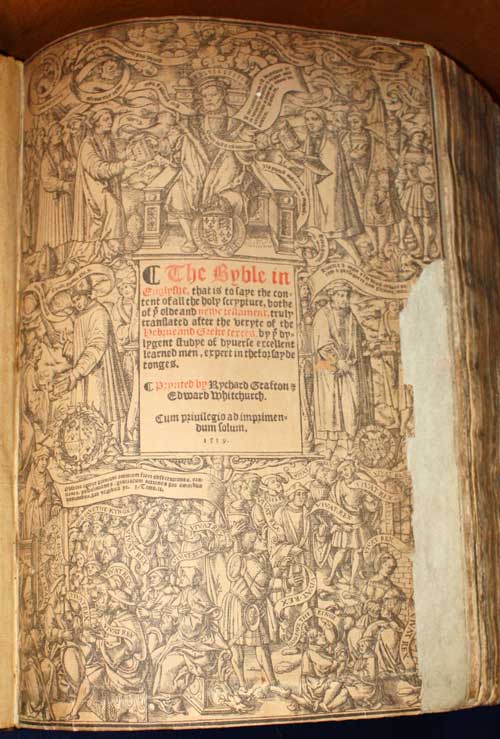
|
|
Title page of Great Bible, 1539.
|
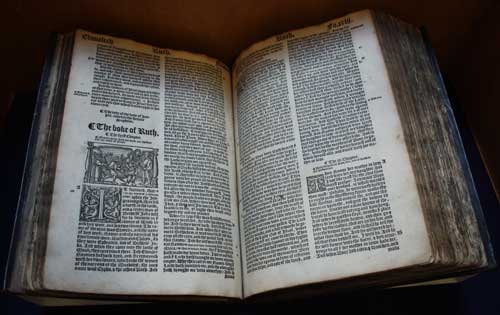
|
|
Book of Ruth, Great Bible, 1539.
|
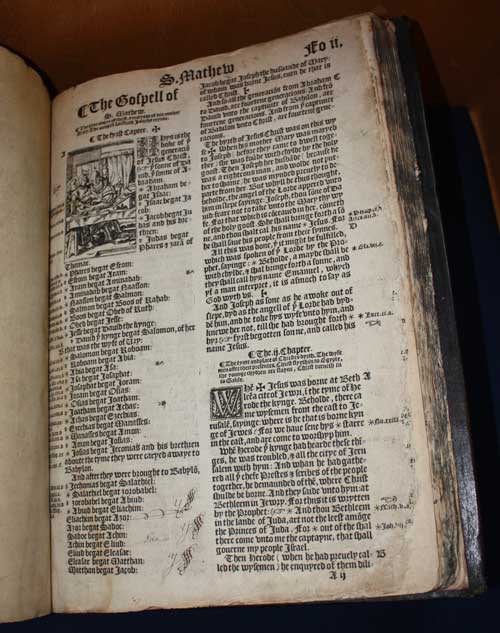
|
|
Gospel of St. Matthew, Great Bible, 1539.
|
Church of England
The Holy Byble: Conteyning the Olde Testament and the Newe set foorth by aucthoritie
London: Imprinted ... by the assignement of Christopher Barker, 1578.
[24], 102, 145, 156, 102, 132 leaves : ill. ; 35 cm
Known as the Bishops' Bible, produced by the Church of England to correct or respond to the thorough Calvinism of the Geneva Bible and other perceived shortcomings of the Great Bible. First published in 1568, the Bishops' Bible was re-issued in an extensively revised form in 1572.
Note the excellent woodcut, illustrating many of the familiar stories recounted in Genesis.
Graduate Theological Union Library Collection. Gift of the Reverend W. C. Schaeffer.
|

|
|
Book of Genesis, Bishop's Bible, 1578.
|

|
|
Map of Holy Land, Bishop's Bible, 1578.
|
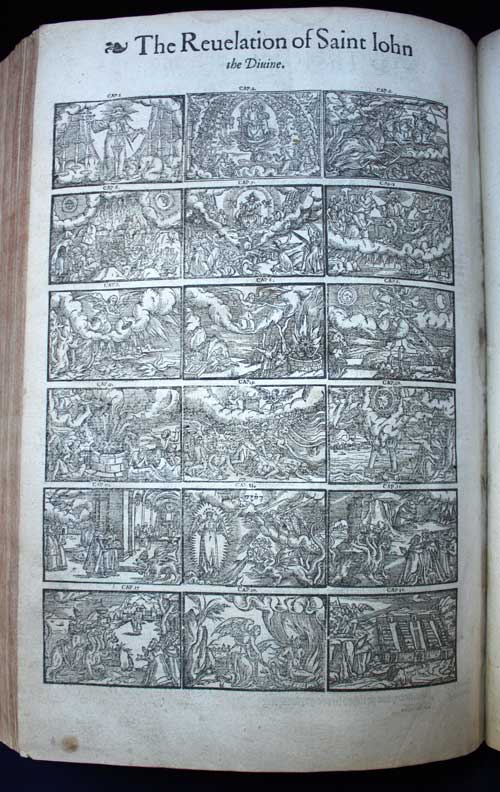
|
|
Book of Revelation, Bishop's Bible, 1578.
|
Church of England,
The Bible: Translated According to the Ebrewe and Greeke
London: By Christopher Barker, 1585.
3 pts. in 1 v. ; 23 cm. (4to)
The Geneva Bible also known as the Breeches Bible because of the translation of
Genesis 3:7:
So the woman (seeing that the tree was good for meate, and that it was pleasant to the eyes, and a tree to be desired to get knowledge) tooke of the fruite thereof, and did eate, and gaue also to her husband with her, and he did eate. Then the eyes of them both were opened, and they knewe that they were naked, and they sewed figge tree leaues together, and made them selues breeches.
Important innovations in the design of the book include commentary and other marginal notes authored by John Calvin, John Knox, Miles Coverdale, William Whittingham, Theodore Beza, Anthony Gilby, and other leaders of the Reformation.
King James I considered the marginal notes to be: partial, untrue, seditious, and savouring of dangerous and traitorous conceits.
Graduate Theological Union Library Collection
|
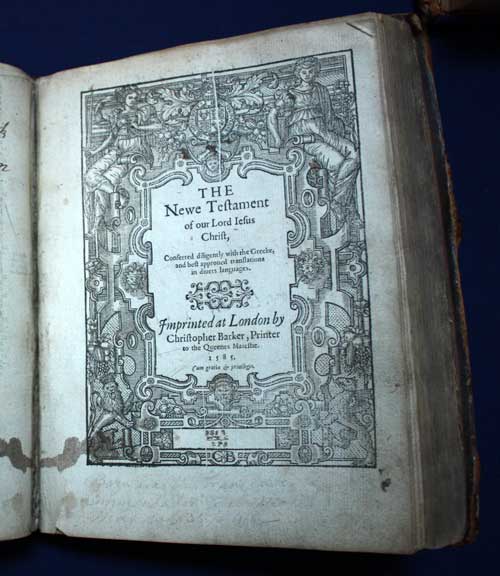
|
|
Title page of New Testament, Geneva Bible, 1585.
|

|
|
Gospel of St. Matthew, Geneva Bible, 1585.
|











